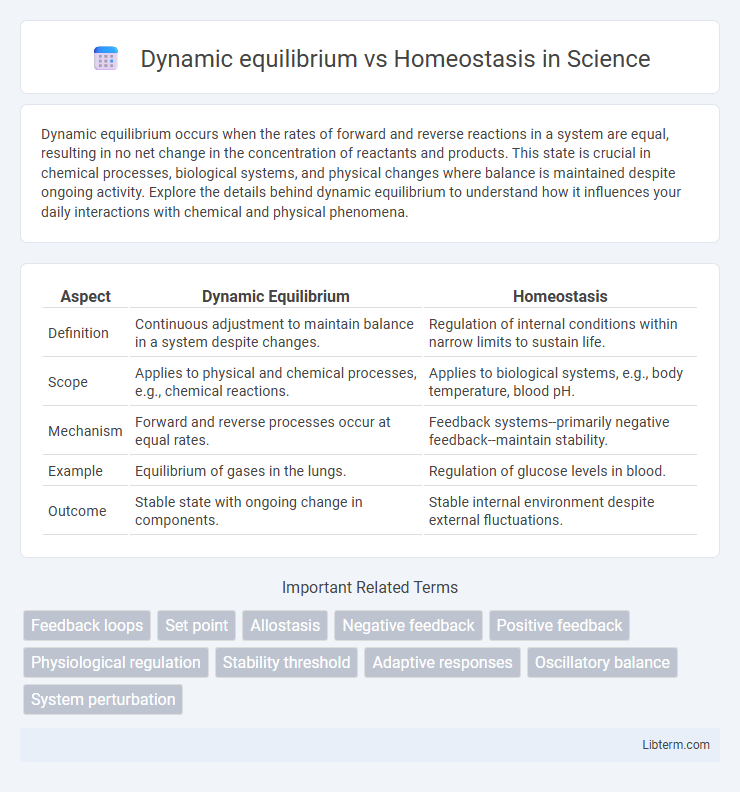Dynamic equilibrium occurs when the rates of forward and reverse reactions in a system are equal, resulting in no net change in the concentration of reactants and products. This state is crucial in chemical processes, biological systems, and physical changes where balance is maintained despite ongoing activity. Explore the details behind dynamic equilibrium to understand how it influences your daily interactions with chemical and physical phenomena.
Table of Comparison
| Aspect | Dynamic Equilibrium | Homeostasis |
|---|---|---|
| Definition | Continuous adjustment to maintain balance in a system despite changes. | Regulation of internal conditions within narrow limits to sustain life. |
| Scope | Applies to physical and chemical processes, e.g., chemical reactions. | Applies to biological systems, e.g., body temperature, blood pH. |
| Mechanism | Forward and reverse processes occur at equal rates. | Feedback systems--primarily negative feedback--maintain stability. |
| Example | Equilibrium of gases in the lungs. | Regulation of glucose levels in blood. |
| Outcome | Stable state with ongoing change in components. | Stable internal environment despite external fluctuations. |
Introduction to Dynamic Equilibrium and Homeostasis
Dynamic equilibrium refers to a continuous state of balance where opposing processes occur simultaneously at equal rates, maintaining internal stability despite external changes. Homeostasis is the biological process by which organisms regulate internal conditions such as temperature, pH, and glucose levels to sustain optimal functioning. Both concepts emphasize the dynamic nature of balance, but homeostasis specifically applies to living systems maintaining stable internal environments.
Defining Dynamic Equilibrium: Key Concepts
Dynamic equilibrium refers to a state where continuous processes occur at equal rates, maintaining stability within a system without total cessation of activity. Key concepts include constant change, balance of opposing forces, and system adaptability, often observed in chemical reactions and physiological processes. Unlike homeostasis, which focuses on maintaining internal stability through regulatory mechanisms, dynamic equilibrium emphasizes ongoing, balanced interactions sustaining system function.
Understanding Homeostasis: The Body’s Balance
Homeostasis maintains the body's internal environment within a narrow, stable range through complex feedback mechanisms involving the nervous and endocrine systems. Dynamic equilibrium refers to the continuous adjustments in physiological processes to counteract external and internal changes, ensuring stability. Understanding homeostasis highlights the body's intricate regulation of temperature, pH, glucose levels, and other vital parameters to sustain optimal functioning.
Key Differences Between Dynamic Equilibrium and Homeostasis
Dynamic equilibrium refers to a state where continuous processes balance each other, maintaining system stability through ongoing changes, often seen in physical and chemical systems. Homeostasis specifically involves biological systems regulating internal conditions such as temperature, pH, and electrolyte balance to stay within narrow, optimal ranges despite external fluctuations. Unlike dynamic equilibrium's broader application in physical contexts, homeostasis uniquely includes physiological mechanisms and feedback loops to sustain life.
Roles in Biological Systems: Dynamic Equilibrium vs Homeostasis
Dynamic equilibrium maintains a constant internal environment by balancing ongoing processes, such as the fluctuating glucose levels during metabolism. Homeostasis involves regulatory mechanisms that detect deviations from set points and initiate corrective actions, like thermoregulation maintaining body temperature. Both processes are essential for biological systems to sustain stability but operate through different methods--dynamic equilibrium through continuous balancing and homeostasis through feedback control systems.
Examples of Dynamic Equilibrium in Nature
Dynamic equilibrium in nature is exemplified by the water cycle, where continuous processes of evaporation and condensation maintain a balanced state. Another example includes predator-prey relationships, which regulate population sizes through ongoing interactions without permanent shifts. Additionally, chemical reactions in ecosystems, such as nitrogen fixation and decomposition, demonstrate dynamic equilibrium by sustaining nutrient balance.
Homeostasis in Human Physiology
Homeostasis in human physiology refers to the body's ability to maintain a stable internal environment, such as regulating temperature, pH, and glucose levels despite external fluctuations. Dynamic equilibrium involves continuous adjustments where physiological processes like sweating or shivering respond to changes to restore balance. Key systems such as the endocrine and nervous systems coordinate these responses, ensuring optimal functioning of organs and cellular activities.
Feedback Mechanisms: Maintaining Balance
Feedback mechanisms play a crucial role in maintaining dynamic equilibrium and homeostasis by regulating physiological processes through continuous monitoring and adjustment. Negative feedback loops counteract deviations from a set point, such as temperature regulation or blood glucose levels, restoring internal stability. Positive feedback amplifies responses in specific scenarios, like blood clotting or childbirth, ensuring vital processes proceed efficiently toward a defined endpoint.
Importance of Dynamic Equilibrium and Homeostasis in Health
Dynamic equilibrium maintains constant internal conditions by balancing physiological processes such as temperature regulation and pH levels, preventing harmful fluctuations. Homeostasis regulates critical functions like blood glucose, electrolyte balance, and osmotic pressure, crucial for cellular function and overall metabolic stability. Disruption in either dynamic equilibrium or homeostasis can lead to diseases such as diabetes, hypertension, or acidosis, highlighting their essential roles in sustaining health.
Conclusion: Integrative Perspectives on Biological Balance
Dynamic equilibrium and homeostasis both describe processes maintaining biological balance through continuous adjustments in response to internal and external changes. While dynamic equilibrium emphasizes fluctuating yet stable conditions in chemical or physical systems, homeostasis encompasses complex physiological mechanisms that sustain internal stability in living organisms. Integrating these perspectives highlights how organisms rely on dynamic feedback loops and regulatory networks to achieve adaptive balance essential for survival and health.
Dynamic equilibrium Infographic

 libterm.com
libterm.com